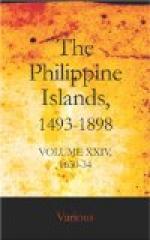[63] Fray Esteban Peralta held various charges in the province of Castilla before going to the Philippines. He was stationed in the islands at the mission in Cebu, being proposed several times as provincial. In 1623 he was procurator-general, in 1626 definitor, and was at the missions at Tondo (1629) and Hagonoy (1632), where he died. See Perez’s Catalogo, p. 98.
[64] Fray Jeronimo Medrano was a native of Estella, and took his vows at the convent of Soria in 1604. He labored in the missions of Caruyan (1615), Quingua (1617), Malolos (1620), Taal (1621), Hagonoy (1623), Paranaque (1629), and Tondo (1638 and 1647). He was definitor and visitor, and three times provincial (1632, 1641, and 1650). His death occurred in 1656. See Perez’s Catalogo, p. 88.
[65] Fray Alonso Carbajal was a native of Salamanca, and professed in the province of Castilla, where he read sacred theology and obtained the degree of master. Dates regarding his life are meager. He was prior of Manila in 1623 and 1653; of Guadalupe, 1638; definitor, 1626 and 1653; visitor and provincial, 1644; while he renounced several bishoprics. Besides this he had charge of mission work in Guagua in 1620, Macabebe in 1632, and Bacolor in 1650, after which he served in the Bisayas until his death. See Perez’s Catalogo, pp. 96, 97.
[66] Kings III [i.e., Kings I of the Protestant version], v, 4.—Coco.
[67] Fray Pedro de Torres was born in Andalucia. He ministered in the Philippines in Mambusao in 1629, and at Oton in 1632, dying in Manila about 1633. See Perez’s Catalogo, p. 100.
[68] Fray Juan Gallegos was a native of Mancha, and took his vows in the convent at Burgos. He was Ilocan minister at the town of Narvacan (1620) and Laoag (1623). He refused an appointment (1625) as procurator to Spain and Rome, preferring to devote himself to his ministry. He was at Bantay in 1626 and 1630; at the villages of Candon in 1629, 1635, and 1644; and Bauang in 1633. He was subprior in 1617, and twice definitor and visitor, dying in 1648 at Candon. See Perez’s Catalogo, p. 94. He is to be distinguished from the other Augustinian religious of the same name who died while definitor in 1581.
[69] Fray Francisco del Portillo was one of the best orators of his time. He died in 1628 after exercising the care of souls in Purao in 1626, and taking possession of the land necessary to found a convent in Formosa. See Perez’s Catalogo, pp. 103, 104.
[70] “They hanged them on gibbets in the sight of the sun.”
[71] Fray Francisco de Santa Maria Oliva took his vows in the Toledo convent in 1581. He was minister of Dumaguete in 1599, and later of Potol, Ibabay, Mambusao, and Jaro, until 1628, when he died. See Perez’s Catalogo, p. 38.
[72] In the text, actuanse, which is apparently a misprint for actuante.
[73] Perez (Catalogo, p. 107) says that this friar, whom he calls Bartolome Blas Esterlich, was from Flanders. He was a confessor and preacher in Manila, and ministered in the Ilocan villages of Bangui (1633) and Agoo (1635), dying in 1640.




